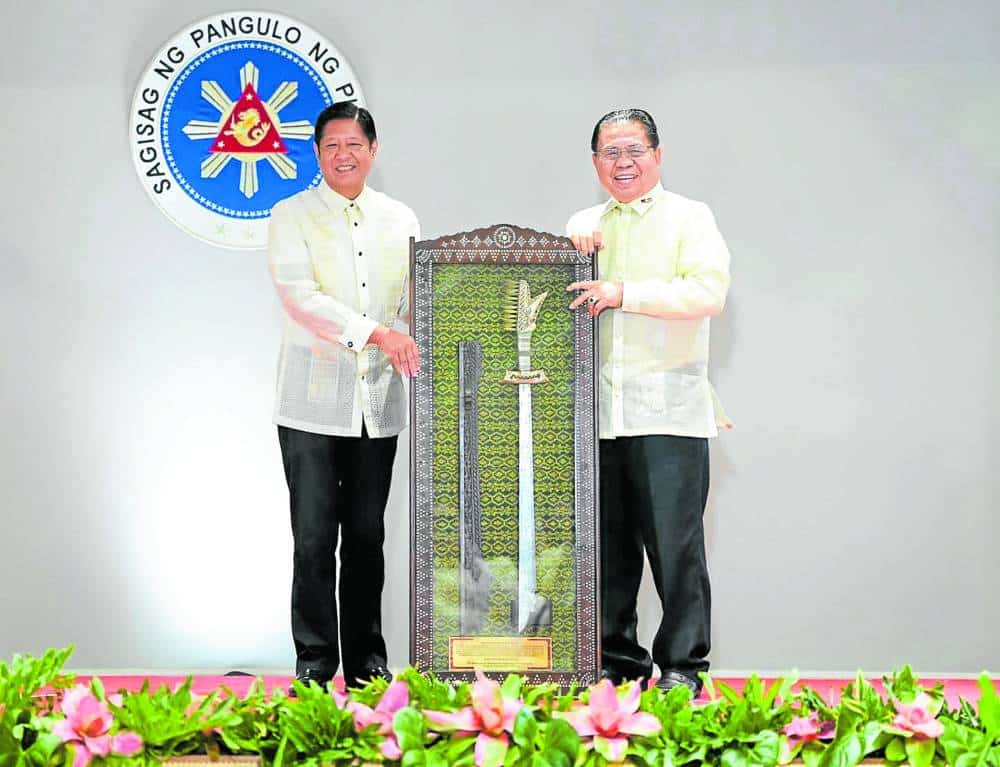BARMM poverty incidence drops, but still among PH’s poorest

GESTURE OF GRATITUDE Bangsamoro Autonomous Region in Muslim Mindanao Interim Chief Minister Ahod “Al Haj Murad” Ebrahim presents a Bangsamoro “kampilan” (sword) to President Marcos last Aug. 1 in gratitude for his support for Moro political empowerment and autonomy. —Photo courtesy of Presidential Communications Office
DAVAO CITY, Philippines — While it posted a continuous decline in poverty incidence in the last six years, the Bangsamoro Autonomous Region in Muslim Mindanao (BARMM) has yet to escape the clutches of poverty, recent data released by the Philippine Statistics Authority (PSA) showed.
According to the PSA report released on Aug. 15 this year, the Bangsamoro region posted a 23.5-percent poverty incidence last year, a decline by 4.5 percentage point from the 28 percent posted in 2021 and more than 50 percent down from the 52-percent poverty level it posted in 2018.
READ: Marcos wants BARMM autonomy rules expedited
However, the region remains among the country’s poorest, second only to Zamboanga Peninsula or Region 9, with the latter posting a poverty incidence of 24.2 percent last year, an increase from the 23.4-percent level in 2021.
Still, Bangsamoro has at least shed off its label as the country’s poorest.
Article continues after this advertisementAccording to the report, a family of five in the Bangsamoro needs at least P13,873 per month to meet their minimum basic food and nonfood needs in 2023.
Article continues after this advertisementAverage family income
Among the regions, the BARMM also registered the lowest average annual family income at P206,880, compared to Zamboanga Peninsula’s P257,140, and Negros Island region’s P266.29.
The National Capital Region (NCR) registered the highest average annual family income at P513,520 in 2023; followed by Calabarzon, at P426,530; and Central Luzon, at P375,240.
Programs
Average annual family expenditure also remained at its lowest in the BARMM at P168,910; followed by Mimaropa at P189,770; and Eastern Visayas at P199,910. The NCR posted the highest average family expenditure at P385,000; followed by Calabarzon, at P310,320; and Central Luzon, at P298,700.The BARMM’s Bureau of Information Office attributed the slight improvement in the region’s poverty statistics to various programs being implemented in the Bangsamoro, such as the Kapayapaan sa Pamayananan program which distributes housing and other projects providing livelihood to the communities, among others.
This developed as the BARMM also turned over new housing units to 100 families in two newly created towns in the BARMM’s Special Geographic Area (SGA) the previous week.
The BARMM’s Ministry of Human Settlement turned over the two-bedroom houses, built through funds from the regional government, to 50 families in Barangay Nabalawag in the newly-created Nabalawag town and another 50 units to 50 families in Barangay Tumbras, Kadayangan town in the SGA on Aug. 12. Both towns were carved out from Midsayap, Cotabato province, and their creation was ratified through a plebiscite on April 13 this year.